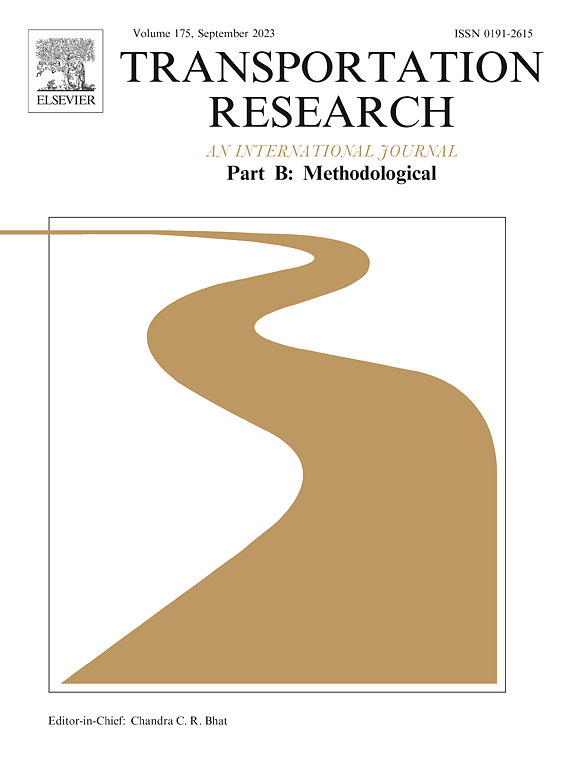基于双模式双串联瓶颈的早晨通勤网约车服务的路边拥堵效应建模
IF 6.3
1区 工程技术
Q1 ECONOMICS
引用次数: 0
摘要
随着网约车服务的普及,由于大量的乘客上下车,城市的道路空间变得非常拥挤。特别是在高峰时段,等待下车的大量网约车堵塞了路边空间,甚至扰乱了干线交通的流动。然而,目前还缺乏一种分析模型来阐述和减轻叫车服务在路边停车造成的拥堵影响。为了解决这一问题,本文提出了一种新的双模式双串联瓶颈模型来描述线性城市早高峰私家车和网约车的通勤行为。在该模型中,上游瓶颈模型描述了高速公路上的拥堵情况,下游路边瓶颈描述了市区内由路边停放的RV、主干道上的PV排队引起的拥堵以及它们之间的溢出效应。该模型可以在八种不同的情况下以封闭形式求解。为了实现社会最优,提出了一种时变最优拥堵收费方案,即路边收费和停车收费相结合的最优拥堵收费方案。研究发现,当公路瓶颈与路边瓶颈不匹配时,会产生道路容量的潜在浪费,因此需要协调确定最优定价。香港的一个现实案例表明,市区有限的路缘空间和主要道路可能是主要的拥堵瓶颈。扩大市区路边空间或主干道的容量,而不是公路瓶颈,可以有效降低社会成本。本文强调了路边管理的关键作用,并为公路和路边空间的协调管理提供了政策启示。本文章由计算机程序翻译,如有差异,请以英文原文为准。
Modeling the curbside congestion effects of ride-hailing services for morning commute using bi-modal two-tandem bottlenecks
With the proliferation of ride-hailing services, curb space in urban areas has become highly congested due to the massive passenger pick-ups and drop-offs. Particularly during peak hours, the massive ride-hailing vehicles waiting to drop off obstruct curb spaces and even disrupt the flow of mainline traffic. However, there is a lack of an analytical model that formulates and mitigates the congestion effects of ride-hailing drop-offs in curb spaces. To address this issue, this paper proposes a novel bi-modal two-tandem bottleneck model to depict the commuting behaviors of private vehicles (PVs) and ride-hailing vehicles (RVs) during the morning peak in a linear city. In the model, the upstream bottleneck models the congestion on highways, and the downstream curbside bottlenecks depict the congestion caused by RV drop-offs in curb spaces, PV queue on main roads, and the spillover effects between them in the urban area. The proposed model can be solved in a closed form under eight different scenarios. A time-varying optimal congestion pricing scheme, combined curbside pricing and parking pricing, is proposed to achieve the social optimum. It is found that potential waste of road capacity could occur when there is a mismatch between the highway and curbside bottlenecks, and hence the optimal pricing should be determined in a coordinated manner. A real-world case from Hong Kong shows that the limited curb space and main road in the urban area could be the major congestion bottleneck. Expanding the capacity of the curb space or the main road in the urban area, rather than the highway bottleneck, can effectively reduce social costs. This paper highlights the critical role of curbside management and provides policy implications for the coordinated management of highways and curb spaces.
求助全文
通过发布文献求助,成功后即可免费获取论文全文。
去求助
来源期刊
CiteScore
12.40
自引率
8.80%
发文量
143
审稿时长
14.1 weeks
期刊介绍:
Transportation Research: Part B publishes papers on all methodological aspects of the subject, particularly those that require mathematical analysis. The general theme of the journal is the development and solution of problems that are adequately motivated to deal with important aspects of the design and/or analysis of transportation systems. Areas covered include: traffic flow; design and analysis of transportation networks; control and scheduling; optimization; queuing theory; logistics; supply chains; development and application of statistical, econometric and mathematical models to address transportation problems; cost models; pricing and/or investment; traveler or shipper behavior; cost-benefit methodologies.

 求助内容:
求助内容: 应助结果提醒方式:
应助结果提醒方式:


